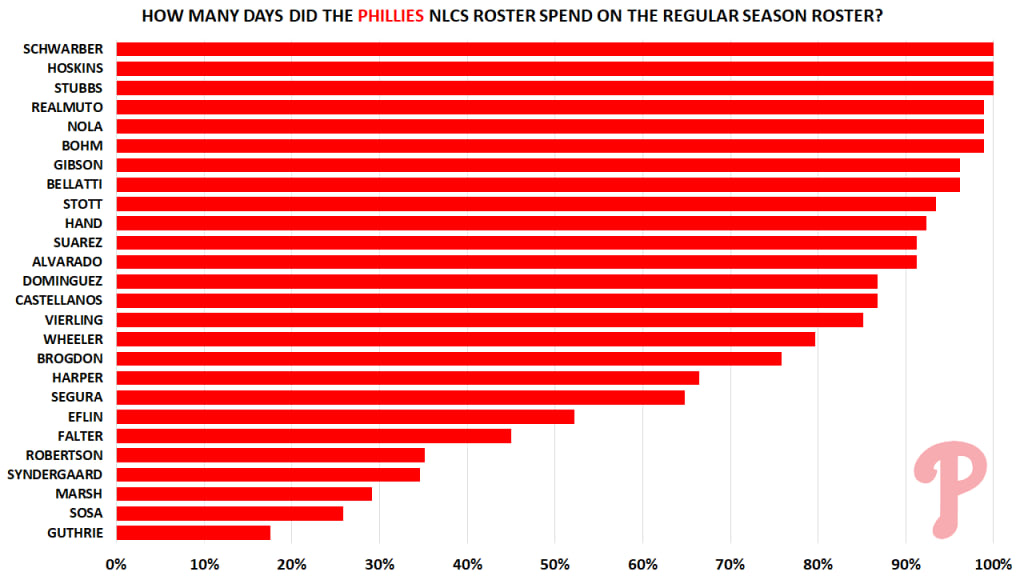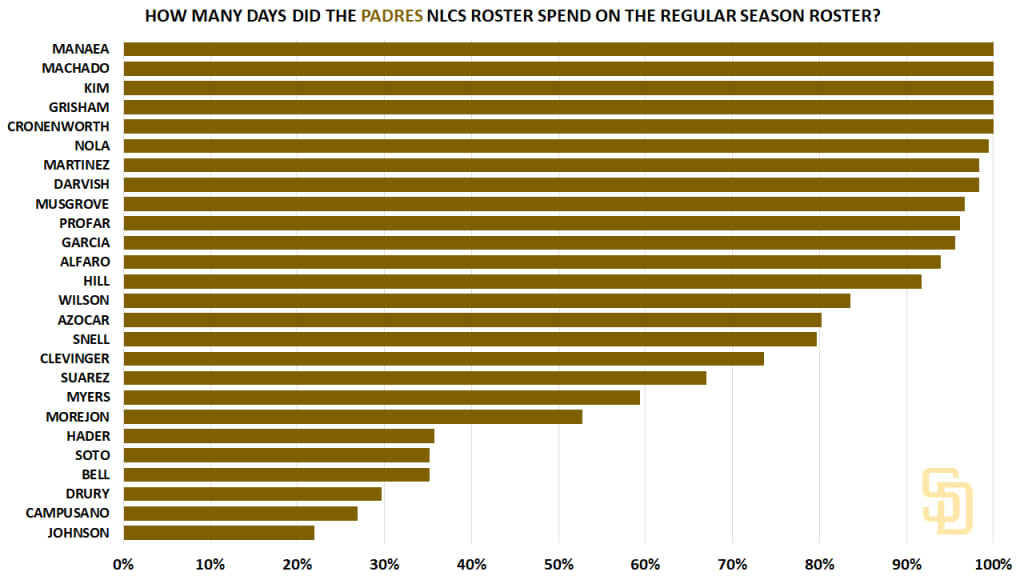The Padres (89 wins) and the Phillies (87) each won fewer than 90 games in the 2022 regular season, and they are facing off in the National League Championship Series for a trip to the World Series (the Phils took Game 1, 2-0, on Tuesday). Meanwhile, the Dodgers (111 wins), Mets (101) and Braves (101) are already home for the winter, having seen their excellent regular seasons collapse in the early rounds of the playoffs.
That, depending on how you look at it, is either a great outcome (what¡¯s more exciting than David toppling Goliath! We watch for upsets!) or a disastrous one (why doesn¡¯t the playoff system reward regular season success more?!) Those are fair enough questions each, but that¡¯s not what we¡¯re going to get to today, because there¡¯s something more interesting to consider.
When we think about the quality of a team over the course of a season, we obviously start with the win total, and there¡¯s no changing the fact that the Padres won 89 and the Phillies won 87. But the players we¡¯ll see in this series, this week, the ones that will actually decide the outcome of the NLCS ¡ they¡¯re not all the same players that got these teams to 89 and 87 wins, are they? They are not.
So maybe the real question isn¡¯t worrying about their seasonal win totals. Maybe the better question is: How good are these rosters, really? How different are they from what we saw over the course of the full season?
On May 17, the Padres beat the Phillies 3-0 in their first meeting of the season. Eric Hosmer started at first base, with Robinson Can¨® at designated hitter. The final four innings were thrown by MacKenzie Gore and Taylor Rogers, who helped shut down a Phillies lineup written by manager Joe Girardi that included Odubel Herrera and Roman Quinn in the outfield. One of the biggest hits of the game came in the seventh, when Can¨® singled off James Norwood to drive home the second run. None of those names remain with these teams.
Meanwhile, that same night, Josh Hader was in Milwaukee as his Brewers mates faced the Braves. Juan Soto and Josh Bell were in Miami with the Nationals, losing 5-1 to the Marlins. Brandon Drury was in Cleveland, reaching base three times as the Reds won 5-4 over the Guardians. Noah Syndergaard and Brandon Marsh were in Texas, losing 10-5 to the Rangers. David Robertson was over in Pittsburgh with the Cubs. Bryce Harper was in the midst of a week off nursing his injured right elbow.
You get the idea. You don¡¯t handwave away what happened when Jeurys Familia pitched or Hosmer hit, no matter how well or poorly, because it matters and it counts. It also doesn¡¯t tell you a whole lot about the NLCS, either.
In fact, we can look at the NLCS rosters and tell you exactly how much of it differs from the regular season.
How much of the season did the NLCS roster play for these teams?
Phillies
Philadelphia¡¯s NLCS roster consists of 26 players, with the only change from the NLDS being to restore injured reliever David Robertson at the expense of Nick Nelson. (Poor Nelson, by the way, who was one of just four Phillies to spend every single day of the season on the active roster -- but has now been left off two of the three postseason rosters.)
If we look at the 26 players and see how many days they were on Philadelphia's active roster in the regular season, you can see how much shuffling there's been around the bottom end.

There were four players who spent at least half the year on the active roster but aren¡¯t on the NLCS roster; aside from Nelson, there¡¯s the injured Corey Knebel (71%), and Familia and Herrera, each released after the Trade Deadline. Gregorius, at 48% of the season, came in just under that -- as did Johan Camargo (44%).
Meanwhile, there¡¯s six players here who spent less than half the year with the team, and nine -- including Harper and Jean Segura -- who were not with the team for at least one-third of the season.
Padres
For San Diego, their roster is the same as it was for the NLDS, but considerably different than it was at the start of the season.
There¡¯s five players who spent at least 50% of the year on the active roster but are not here -- reliever Nabil Crismatt (87%), Hosmer (64%), Rogers (63%), Craig Stammen (63%) and Gore (56%), plus Luke Voit, who just missed. They also have six players on the roster who were there for less than half the year -- including Hader, Bell and Soto, all at 36%.

But this week, you can take all those 36 percents and 57 percents and turn the dial all the way up to 100%, aside from injury.
Phillies will have Harper for all of this series, not two-thirds of it; his playing time will come from what had previously gone to Herrera, Quinn or Mickey Moniak. The Padres will have Hader, Soto and Bell for all of this series, not one-third of it. We¡¯ll acknowledge that Bell has not played well since the trade, but you¡¯d certainly prefer Soto to Nomar Mazara, or Hader to Crismatt or Rogers. That¡¯s especially true over a full six-month season, but it should also matter over a week of postseason baseball.
For example: Soto had a 3.6 WAR season, 1.0 of which came with the Padres. All other San Diego right fielders combined had a 0.6 WAR. Hader, after a rough start to his San Diego career, was one of the three best relievers in baseball in September and into the postseason.
For another example: Segura had a 1.7 WAR season in 98 games, despite missing two months with a broken finger. Gregorius, who had garnered much of the middle infield time earlier in the season and while Segura was out, offered a -0.3 WAR in 63 games.
You do that with every upgrade, and suddenly these are rosters that would have been projected to have win totals that started with nine, not eight.
It¡¯s not always quite as clean as that, of course. As we said: Bell has been disappointing. Drury¡¯s been just OK. Syndergaard has been ¡ adequate. But the takeaway here is that some of the biggest stars we¡¯ll see -- Hader, Soto and Harper among them -- simply weren¡¯t available to their teams for much of the year. They may have won 89 and 86 games, but the talent level available right now exceeds that.
Now: There¡¯s one wrench to throw into all of this, and that¡¯s how the season ended. These two teams didn¡¯t exactly make some moves and live happily ever after, did they? The Phillies went 14-17 in September and October, nearly blowing the Wild Card gift the faltering Brewers offered them. The Padres were a .517 team through the Trade Deadline and a .517 team after it.
It's easy to talk about a higher level of talent, and harder to sell it when it didn't immediately lead to wins, though that's easily explained by the fact that the post-trade/injury struggles of Soto, Hader and Harper look more flukish than anything, given not only their track records but also the fact that they've each been performing at a much more representative level over the last few weeks. When one of them gets to the World Series, Houston or New York won't be facing the Padres or Phillies of April or May. They'll be facing the ones from October.
Still, there¡¯s not a version of this where the current Padres or Phillies rosters are better than the rosters of the Braves, Dodgers or Mets, because success over 162 games tells you a lot more than success over a few weeks. That¡¯s just not what the playoffs are.
But if we've learned anything so far this October, it's that in a short time span, the most talent does not always lead to the most wins. If this all sounds familiar, it¡¯s because the 2021 Braves, who won 88 games, followed the same script. They weren¡¯t the best team of the regular season (though they did win their division). They got hot at the right time, and they relied heavily upon players who weren¡¯t there for much of the season -- like Joc Pederson, Jorge Soler, Adam Duvall and Eddie Rosario.
We don't know if the 2022 Phillies or Padres will end up following the same script. We do know, though, that the teams will see this week aren't exactly the same ones we've seen all year.

